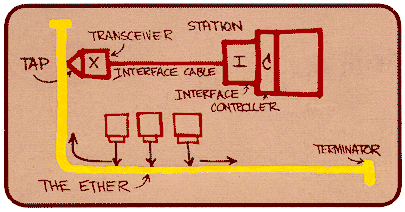| Home |
The Network Programming page |

A drawing of the first Ethernet system by Robert Metcalfe.
Image from Charles Spurgeon's Ethernet Web Site
Before I begin, here is what I intend to take away with me at the end of the Semester.
Things I want to learn from this Course
The Pit Stops
Now that you know where we are heading, why don't you ride along as I journey through the fascinating
world of Network Programming and Internet Technologies.
Visit the links below to see the stops I have made on the way. The journey has just begun, do keep
visiting for the latest developments.
- Query Processing for a Search Engine
- The students of the network programming class are currently involved in making a search engine. I am a part of the
query processing team and our inital proposal can be viewed here (html, ps).
- Unicode, UTF-8 and Devanagari
- Fruits of many hours of labour, here is a little of what I understood about Unicode, UTF-8 and Devanagari. You will also learn
how to install Devanagari fonts in Linux and using "Yudit", the Unicode Text Editor. What are you waiting for?
- Hindi Translation of: Putting mathematics on the Web with MathML
- Ashish Gupta, Ramasya and I have translated the Putting mathematics on
the Web with MathML document, published by the World Wide Web Consortium (W3C), into Hindi.
The translated document is available on the website of the W3C.
The list of all W3C documents currently available in Hindi can be viewed
here. To learn how to create a multilingual webpage, read
the tutorial on Unicode given above.
- The Domain Name System (DNS)
- Well, I finally took the plunge and after two days of hard work, I think I understand the DNS. Hoping to increase my knowledge, I am
sharing what I learnt with you. Go ahead and master the DNS.
- Simple Mail Transfer Protocol (SMTP)
- As the name suggests, SMTP is a simple protocol that is used by mail servers to transfer email among themselves. You
should read this to learn how email makes its way from your computer to your loved ones.
- POP3 and IMAP4
- If you have used mail clients, you must have heard of POP3 and IMAP4. Take a look at why we need them.
There is also a detailed description of POP3, including how to talk with a POP3 server using Telnet. For people within
CSA who are having problems with Telnet, there is a solution.
- Format of Email Messages: RFC 822 and MIME
- This page describes the format of email messages as specified by RFC 822 and its successor, MIME or Multipurpose
Internet Mail Extensions. You will see how a mail system that was designed to handle text-only data has been extended to
allow sending of binary data such as images, audio etc. as attachments.
- My experiments with XML
- This page will show you how I created my first XML document.
- My experiments with XHTML and CSS
- Learn about the benefits of usign XHTML and CSS. You can also view the Style Sheet for my website and
some great links where you can learn more.
- Ethernet
- My collection of links on ethernet. For the technically competent only.
- Request for Comments (RFC)
- The way ideas are exchanged on the Internet. Some of these later become Internet standards. Well, you think standards documents
are boring? Check out these humorous RFCs. Had enough fun? Peek at the
RFC archives maintained by FAQs.org.
Other places you may want to visit
- As We May Think
- This pioneering article by Vannevar Bush was originally published in the July 1945 issue of the Atlantic Monthly. Along with
other futuristic devices, he visualized the "memex", a mechanical information-retrieval device that allowed
"associative indexing", the inspiration for hyperlinks in present hypertext systems.
- Hobbes' Internet Timeline
- The definitive history of the internet. Hobbes' Internet Timeline was released as
RFC 2235 in 1998.
- Programming Perl, 3rd Edition
- Programming Perl, known colloquially as "the Camel book", is authored by
Larry Wall, the creator of Perl. Browse the book online and
learn Perl straight from the camel's mouth.
- World Wide Web Consortium
- "The World Wide Web Consortium (W3C) develops
interoperable technologies to lead the Web to its full potential." Visit their
site to learn more about the latest web technologies and older ones too.
- W3 Schools
- "At W3Schools you will find all the Web-building tutorials you need,
from basic HTML and XHTML to advanced XML, XSL, Multimedia and WAP."
- The Internet Engineering Task Force (IETF)
- "The IETF is a large open international
community of network designers, operators, vendors, and researchers concerned
with the evolution of the Internet and its smooth operation."
- Hypertext Markup Language (HTML)
- Books on HTML available in the Virtual
Library at SunSITE,
Indian Institute of Science.
- Apache HTTP Server
- The Apache HTTP Server is
the most popular web server on the internet, and it is available free ! The
Apache HTTP Server is a project of the Apache Software Foundation.
- Amaya
- Amaya is an open source web browsing and authoring environment created by the W3C to showcase the latest Web technologies.
Among other things, it supports XHTML, CSS, XML, MathML, SVG, RDF, XLink and XPointer. You can also contribute to the project by
writing documentation, code or translations.

 |

